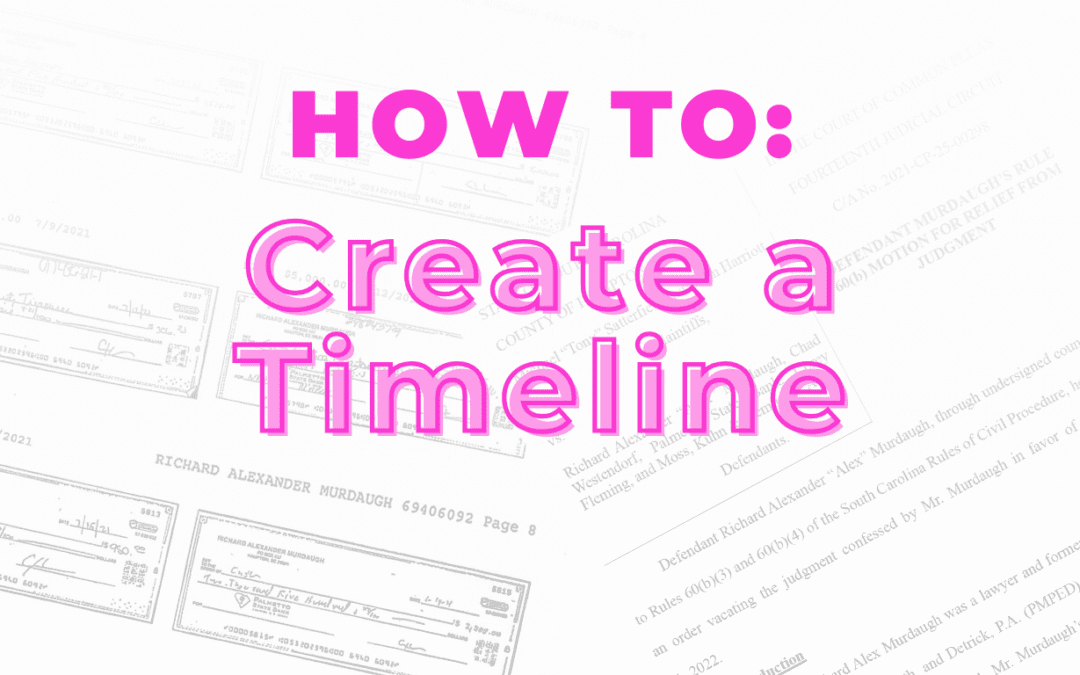When Mandy and Liz left Sandy Smith’s home in 2019, there was a massive amount of information that needed to be broken down, contextualized, and further expounded on.
Sandy had been trying for more than four years at that point to find out what had happened to her son, Stephen Smith, and she’d gathered a large amount of information in a huge binder.
To report on it and make sense of all of the ins and outs, Mandy and Liz needed a timeline.
Here are 5 steps to keeping your facts straight when you build your own timeline to organize all of the events happening in a case.
Start A Master Document
Depending on the size of the event you’re looking at, you may need to add or clarify dates, and that will be easiest if you do it digitally – even if you simply use the notes app on your phone. We prefer Google Docs or Google Sheets for our timelines. Sort the information by date — it’s your choice of whether or not you list your events starting with the oldest date or the newest date first.
Here’s an example using Alex Murdaugh’s trial.
- March 3, 2023 – Alex Murdaugh is sentenced to life in prison for killing his wife and son
- March 2, 2023 – A Colleton County jury finds Alex Murdaugh guilty after about three hours of deliberation
- February 27, 2003 – The defense rested
- February 17, 2023 – The state rested
- February 8, 2023 – A bomb threat is called in, and the courtroom is evacuated.
- January 26, 2023 – The state gives opening statements
- January 23, 2023 – Jury selection began
Note that we could make this timeline way more detailed and include things like who testified what day and which attorneys examined which witnesses. We could also expand this timeline to include pre-trial motions and post-conviction motions.
Gather Good Intel
The only information in your timeline should be information you have vetted for credibility. Generally, we would consider public records credible, for example. Public records include things like police reports, court documents, and minutes of public meetings. Other credible information sources can include news reports, video footage of an event, time and/or stamped emails and text messages, etc.
Keep Track of the Information In the Timeline
You may have copies of information that supports the entries in your timeline. Make sure that your copies are also cataloged (either digitally or physically) in the same order as your timeline.
Stay Focused
Don’t make your timeline too broad, otherwise the most important details might get overlooked, especially if you are creating a timeline to show to law enforcement or to give to a journalist if you need help with something. Keep in mind that some cases are so large that you might need secondary timelines to supplement the main material. In our Alex Murdaugh example, we are doing a trial timeline, but within the trial timeline, we could do another timeline of when witnesses testified or even break down each day with time stamps.
Write Down Questions and Notes As You Go
While organizing information, you may find that you have more questions or notice some patterns. Go ahead and make note of those. You may find the answers as you keep organizing the timeline, but your notes may also give you some ideas about more records you can ask for to help fill in the timeline.
Please sign into your Premium account then refresh this page to view this content.

Contact Beth Braden
Beth Braden
Beth Braden is an award-winning journalist with experience covering government, education and crime and courts for more than 10 years. In addition to following breaking news and writing feature stories about life in her home state of Tennessee, her by-line appears on several internationally known websites.
Beth is passionate about communicating complex information in an easy-to-understand manner and she loves to pore over public records and court documents as she seeks out patterns and context to share with her audience. In her spare time, she enjoys quilting, strange museums, and good cups of coffee.

